Otto von Busch pointed me to this new course of Fashion & Technology at the School of Arts and Communication at Malmö University. The course explores the field through a study of clothing and style as socio-cultural communication and an investigation of how emerging technologies can assist in personal expression. After that, practical workshops invite students to craft their own prototype.
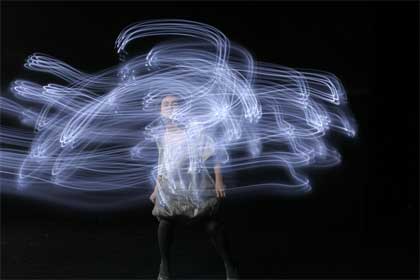 Calle Rosenqvist, Beat Dress (photo by Johan Sundell)
Calle Rosenqvist, Beat Dress (photo by Johan Sundell)
Otto only sent me a few pictures to illustrate the work of the students. Nothing else. But the teaser was good enough, i asked course coordinator Kristina Törnblom to put me in touch with the students so that i could understand better what their projects were about.
First victim of my questions, Emma Thordin Ungesson told me the story of The Drum Suit:
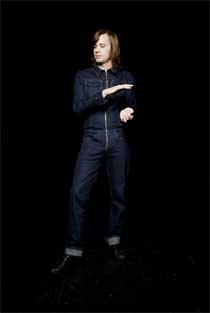
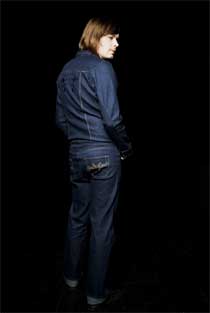 (Photos by Mika Korhonen)
(Photos by Mika Korhonen)
The suit enables the drum player, someone who usually doesn’t get as much attention as the singer and other band members, to play and move freely around the stage during concerts.
“Piezo sensors sewn in the cuffs and under the foot interact with an arduino board that is connected with an midi wire and then in to the computer,” explains Emma. “In the computer, midi files on a midi keyboard generate a bass sound and cymbals sounds. I also peeled off the plastic covers of the piezo sensors to make them more sensitive.”
Because Emma has been quite busy recently the project is on hold but the original plan was to have the midi player sewn in it as well so that it wouldn’t have to be connected to the computer. Another idea is to create similar suits for the whole band.
Lenna Truncale about The Zodiac Dress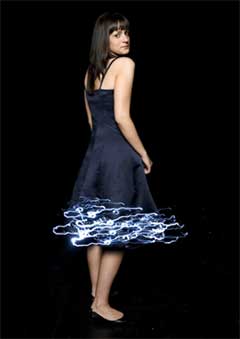
“All 12 zodiac signs are formed by LEDS and sequins on the border of the dress. All signs light up at once, but only one of them lights brighter than the others depending on what month it is,” says Lenna. “Different signs are seen more clearly in the night sky during the year. For example, Taurus is seen most clearly during the month of January, and Gemini in February, and so on. I was actually surprised when doing research for the dress because i believed that the sign was seen most clearly during the month of when their horoscope sign is- for example- I believed Leo was seen during July/ August, but it is actually seen most clearly during April.”
The most challenging aspect about the dress was how time consuming it was. Just to solder 60 lights one by one onto a dress took forever, not to mention how much programing and sewing was involved. The wires would break off or not have contact, so I was constantly re-soldering up into the last day before presentations.
Lenna spent her childhood in California and that’s where the inspiration for the dress comes from, more precisely she wanted to re-create the sky of the desert night sky in Joshua Tree, Ca. “The desert night sky in Joshua Tree is so clear it is unbelievable! you can seen all the stars, the milky way, etc. Being away from that sky for 3 yrs. here in Sweden, has made me realize how much I really miss it.”
(Photo of the Zodiac Dress by Mika Korhonen)
Maja Theselius about the Therapeutic Light Dress
My intentions was to make an outfit that shifts colours inside the collar depending on the mood you were in. The therapeutic dress could either comfort you by showing a scale of colours that are said to be relaxing, e.g. blue, or maybe get your creativity flowing by lighting up in yellow for example.
But then i found out that some questions had to be answered such as: When the dress “feels” that you’re upset – should it enhance your emotions or the opposite? How does it feel it? By the voice? What frequency is more likely to be associated with a particular mood? What should be the trigger? When you start to speak? How often should the
colours change?
In the end, I didn’t solve any of those questions. Because of a lack of both time and knowledge in electronics, i chose to do a simple prototype.”
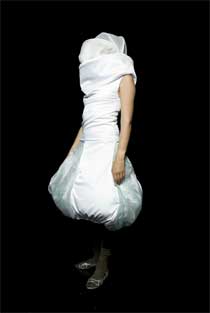
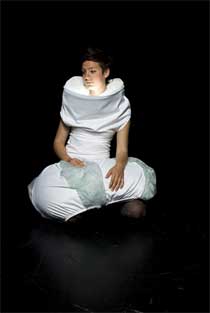 (Photos by Mika Korhonen)
(Photos by Mika Korhonen)
Now about the technology used:
“Inside the collar are six LEDs connected to a 9v battery and an arduino microcontroller. The controller is programmed to run a loop of app 10 different colours, each glows in ≈three seconds then it slowly fades into the next colour.
To give the dress an even more cozy feeling, the inside of the bottom of the dress is filled with the small type of plastic balls you can find in sacco cahir, the fluffy beanbag chair.”
(continue reading the story)
